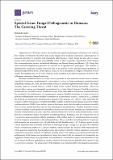Por favor, use este identificador para citar o enlazar a este item:
http://hdl.handle.net/10261/203537COMPARTIR / EXPORTAR:
 SHARE
BASE SHARE
BASE
|
|
| Visualizar otros formatos: MARC | Dublin Core | RDF | ORE | MODS | METS | DIDL | DATACITE | |

| Título: | Special issue: Fungal pathogenesis in humans: The growing threat |
Autor: | Leal, Fernando CSIC ORCID | Fecha de publicación: | 12-feb-2019 | Editor: | Molecular Diversity Preservation International | Citación: | Genes 10(2): 136 (2019) | Resumen: | Approximately 150 fungal species are considered as primary pathogens of humans and animals. The variety of infections that they may cause ranges from localized cutaneous, subcutaneous or mucosal infections to systemic and potentially fatal diseases. Many fungi are also able to cause lesions when abnormal patient susceptibility exists or after traumatic colonization of the fungus (for a comprehensive review on Medical Mycology, see Kwon-Chung and Bennet, [1]). Fungi that infect immunocompromised patients are referred to as opportunistic pathogens. The number of opportunistic fungi has recently increased due to the arrival of new and growing populations of immunocompromised hosts. In this special issue, we have attempted to compile a collection of new studies investigating the role of some virulence traits and their molecular mechanisms of action in the pathogenic outcome of fungal infections. | Versión del editor: | http://dx.doi.org/10.3390/genes10020136 | URI: | http://hdl.handle.net/10261/203537 | DOI: | 10.3390/genes10020136 | Identificadores: | doi: 10.3390/genes10020136 issn: 2073-4425 e-issn: 2073-4425 |
| Aparece en las colecciones: | (IBFG) Artículos |
Ficheros en este ítem:
| Fichero | Descripción | Tamaño | Formato | |
|---|---|---|---|---|
| genes-10-00136-v2.pdf | 182,53 kB | Adobe PDF |  Visualizar/Abrir |
CORE Recommender
Page view(s)
146
checked on 01-may-2024
Download(s)
124
checked on 01-may-2024
Google ScholarTM
Check
Altmetric
Altmetric
Este item está licenciado bajo una Licencia Creative Commons

